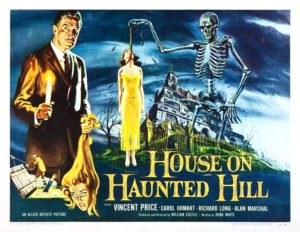 The House on Haunted Hill is one of the earlier horror films I saw growing up. It still stands as one of my favorite “haunted house” films, even though the question of just how haunted (if at all) the house is remains unanswered.
The House on Haunted Hill is one of the earlier horror films I saw growing up. It still stands as one of my favorite “haunted house” films, even though the question of just how haunted (if at all) the house is remains unanswered.
There’s a lot to like right off the top. It’s got Vincent Price in it–so you know there’s at least some style. It’s in classic black and white–so you know there’s at least some atmosphere. It’s from smack in the middle of the horror renaissance, after the Shock Theater package has gone out to TV stations across the country–so you know there was that odd mix of old and new horror to be had.
This is also one of those “horror films for people who don’t like horror films.” Because of its age, there’s not a lot of gore to be had and the overall atmosphere was so prevalent and specific to the time it was made that by today’s standards, it’s almost campy. (Because it’s one of the films that help set all those tropes that are all too familiar now.)
The Plot
The plot is direct: A rich guy and his ostensibly gold-digging trophy wife throw a party in a haunted house and all the guests are supposedly complete strangers. Everyone who survives the night gets $10,000. The door locks at midnight and doesn’t open again until sunrise. There’s no way out and no one other than the hosts and the guests in the house… except maybe the ghosts of the people who were murdered there years earlier.
Needless to say, things go awry. There is death, screaming, confusion, and the subdued sort of mayhem that was common in classic horror films. Tame by today’s standards, yet still just tense enough to keep things interesting.
All the Fun
Really, what makes the film sing is Vincent Price’s performance as amoral host Frederick Loren. The glee he takes at manipulating his guests and the spiteful banter between him and his wife (also played well by Carol Ohmart) manages to walk that fine line between classy and sleazy that only someone like Price can pull off. Without a doubt, this film is the one that really started my appreciation for his style.
This was one of William Castle’s films, which means during it’s original release in theaters there was a gimmick. In the case of House on Haunted Hill, that gimmick was a plastic skeleton that would fly out over the audience during a key scene in the film. I’d imagine that was scary for all of half a second before it was just giggle-worthy. It did get people to come back and see the film again… there are stories of kids making multiple trips so they could throw things at the skeleton when it swung out. That, of course, spoiled it for everyone and that “Emergo” gimmick was done away with quickly.
Aside from real world gimmicks that came into play, the various murders in the film are all a bit gimmicky in and of themselves. Frederick, it seems, is as much a showman as Castle was and more than happy to stage elaborate illusions and scenes to terrify his guests.
There’s a colorized version of the film out there that shows up a lot. I don’t like it anywhere near as much as the black and white version. I think it loses a bit of the atmosphere that makes the black and white version effective.
In 1999, there was a remake of the film. It needlessly complicated the story, added a lot of fancy effects, and managed to lose just about every bit of class the original had. Not that the remake didn’t have anything going for it–there were some fun scares–but it did little, if anything, for the legacy of this film.
The Verdict
You simply can’t be a fan of classic horror without having seen House on Haunted Hill. It’s required watching for fans of Castle and Price. It’s a seminal “haunted house” film–from the initial setup on, it’s a formula that was used many times before and after, on screen and in print. It also holds a pretty solid place in the overall cultural history of horror in the U.S., since it was one of the best known of the gimmick films at the time and then spent a long time in steady rotation on television and home video (thanks in no small part to a copyright snafu that dropped it into the public domain).
Sure, by today’s standards it could seem a bit dull. Definitely a bit corny. But like most classic genre films, the whole trick is to watch is as if you haven’t seen anything that came out after it was released. You have to first and foremost weigh it among its contemporaries, forgetting how over-done some of the “tricks” have become over the decades.
Among all the films that have entertained and inspired me, this one ranks high. The clear progression of the plot, the ostentatious “reveal” at the end, the way some things are just left hanging, but, overall, the style of the closed room mystery set in a place where you’re not sure you can actually see all the players. That makes for a good classic horror film. At least in my book.

Leave a Reply